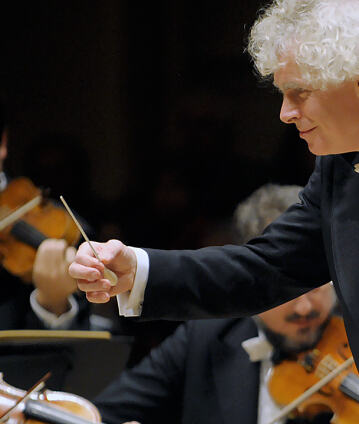Sir Simon Rattle conducts Mahler and Rachmaninov

Mahler was only in his mid-twenties when he wrote his First Symphony, which makes the masterful way in which he employs such vast orchestral forces all the more surprising. The second work of this concert with Simon Rattle contrasts this expression of freshness and new departures: the Symphonic Dances by Sergei Rachmaninov: the composer’s final work, in which he – while in exile in America – invokes the musical language of his Russian homeland.
Gustav Mahler’s First Symphony has the effect of a “volcanic eruption” on Simon Rattle – and the conductor imagines the young composer’s character to have been just as unpredictable, spirited and eccentric. Mahler unites the seemingly incongruous in his monumental first symphony as if there was nothing unusual about it: in addition to the poetry of nature such as cuckoo calls and late-Romantic nostalgic motifs, we also hear folk melodies, some of which are distorted to the point of grotesqueness. In terms of form, the four-movement symphony follows in the tradition of Beethoven, Brahms and Bruckner – at the same time, unconventional sounds hint at a modern tonal language that Mahler would fully establish in his later symphonies. An ambiguity of expression is also central to this style: is the lazily plodding canon Frère Jacques, dressed as a funeral march in a minor key, actually intended to convey mourning – or is it pure satire?
Mahler’s boldness was hotly debated after the first performances of the symphony. Some, especially young music lovers, were enthusiastic – but for many in the audience, the symphony, which Mahler sometimes called “Titan”, had an unsettling effect. But as a composer, Mahler’s time was yet to come – today his symphonies are part of the core repertoire of every major orchestra.
Sergei Rachmaninov’s Symphonic Dances, which he wrote in exile in America at the age of almost 70, are no less complex. Plagued by homesickness and artistically uprooted, the composer wrote nostalgically: “I feel like a ghost wandering in a world grown alien.” In the Symphonic Dances – his last orchestral work – he succeeded in merging the old and new worlds in a fascinating way: melodies of late Romantic pathos meet the pulsating drive of American industrialisation.
© 2010 Berlin Phil Media GmbH
Related interviews
Artists
Our recommendations
- New Year’s Eve Concert with Simon Rattle, Thomas Quasthoff and Pauline Malefane
- Simon Rattle conducts Mahler’s Ninth Symphony in Taiwan
- Simon Rattle conducts “Manon Lescaut”
- Sir Simon Rattle conducts Messiaen
- Simon Rattle conducts a “Late Night” concert à la française
- Sir Simon Rattle conducts “Carmina Burana” at the 2004 New Year’s Eve Concert